MXA RACE TEST: THE REAL TEST OF THE 2020 HONDA CRF250
THE REAL TEST OF THE 2020 HONDA CRF250
Q: FIRST AND FOREMOST, IS THE 2020 HONDA CRF250 BETTER THAN THE 2019 CRF250?
A: Yes. The 2020 CRF250 is the best production version to hit the showroom floors. It handles better and offers improved power from 7000 rpm to sign-off.
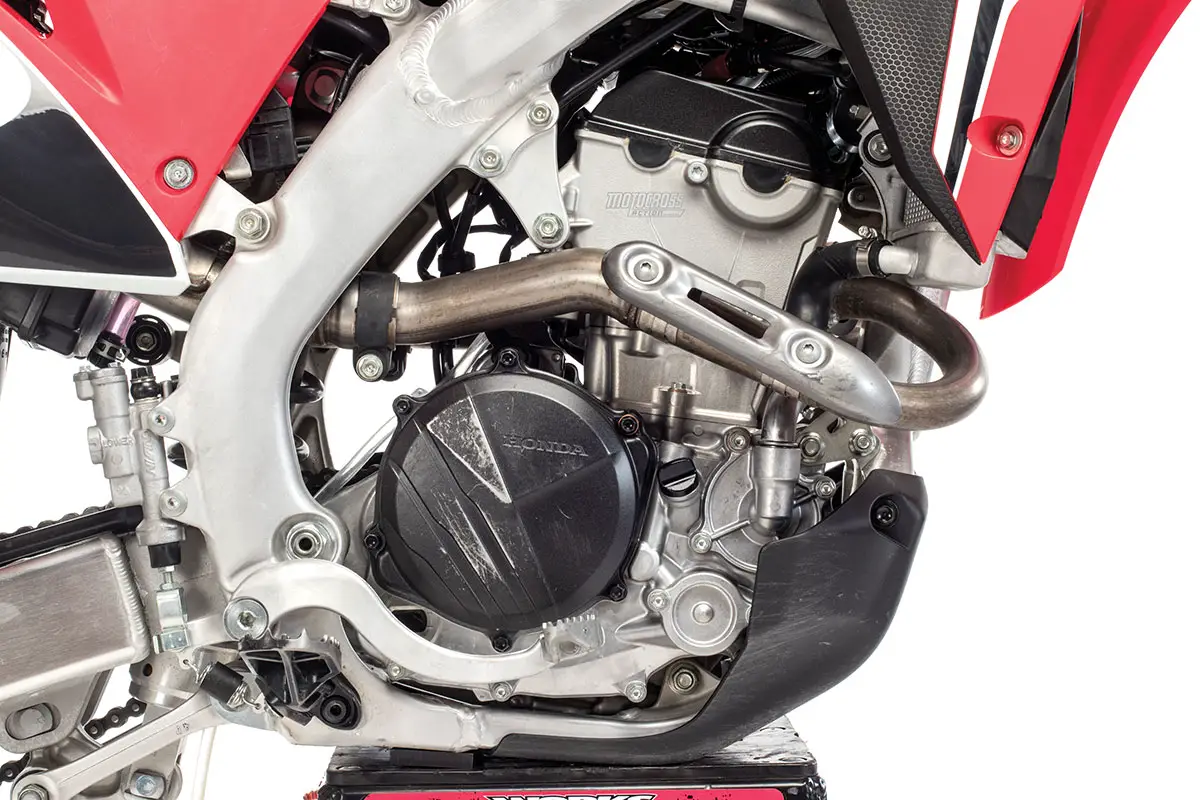
Q: WHAT CHANGES WERE MADE TO THE 2020 CRF250?
A: Even though it looks identical to the 2019 Honda CRF250, there are a laundry list of changes made to the 2020 model. Here is a quick list of what Honda updated for this model year.
(1) Cam profile. An updated cam profile delays the opening of the exhaust valves and reduces valve overlap.
(2) Ignition timing. The timing at 8000 rpm has been updated.
(3) Sensor. A gear-position sensor has been added to allow different ignition maps for each of the five gears.
(4) Head pipe. The resonator on the right header has been removed, and the head pipe diameter has been reduced.
(5) Muffler. The perf core of the muffler flows better, thanks to larger perforation holes.
(6) Radiator. The left-side radiator has been made wider at the top to expand its volume by 5 percent.
(7) Transmission. Second gear has been made taller (going from a 1.80 to 1.75 ratio). Second and third gear have been WPC treated.
(8) Clutch. The clutch plates are thicker, oil capacity has been upped by 18 percent, and the clutch springs are stiffer.
(9) Frame. The frame was upgraded to the 2019 CRF450 frame. The frame’s lateral stiffness, torsional stiffness and yaw angle have been further stiffened for 2020.
(10) Footpegs. The footpegs have fewer teeth but are sharper. Two of the footpeg cross-braces have been removed.
(11) Battery. As on the 2020 CRF450, the battery has been lowered 28mm in order to get more airflow into the airbox and lower the center of gravity. 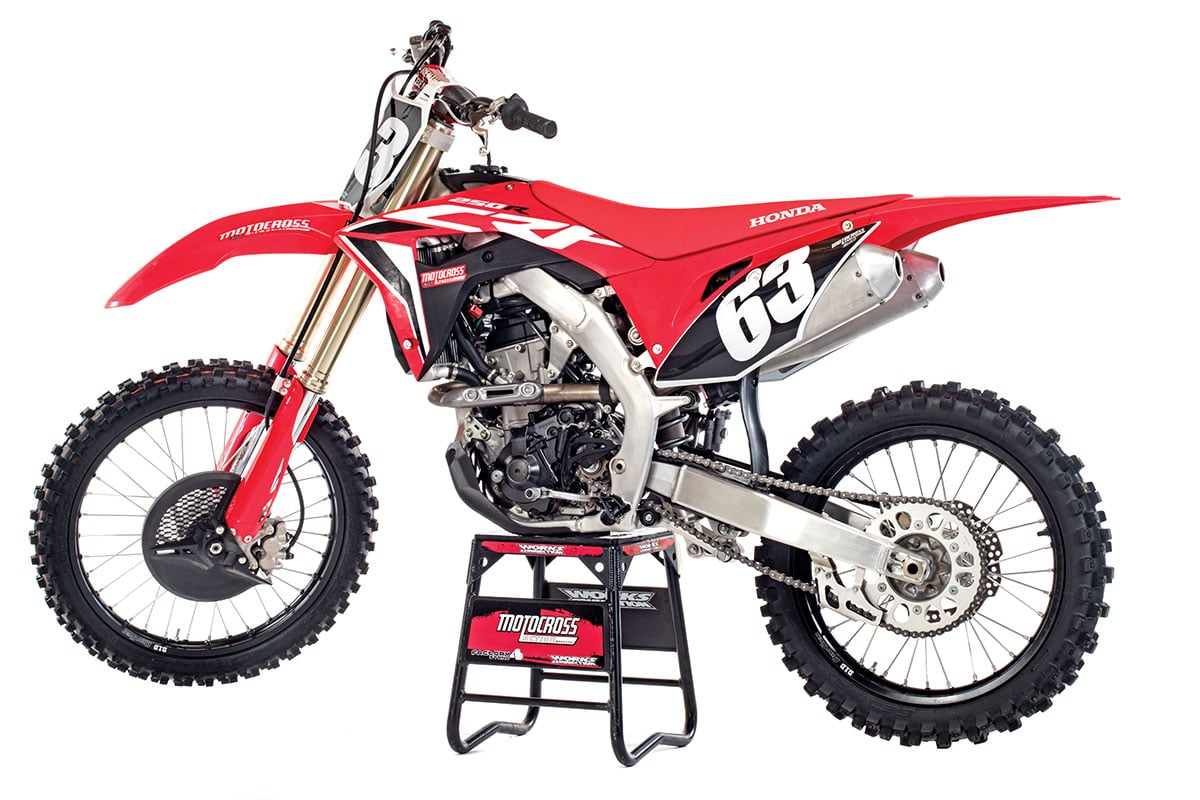 Although the 2020 Honda CRF250 is a beautiful machine, it is also the heaviest 250 four-stroke made and suffers from a lack of low-end throttle response.
Although the 2020 Honda CRF250 is a beautiful machine, it is also the heaviest 250 four-stroke made and suffers from a lack of low-end throttle response.
(12) Suspension. The Showa forks have increased low-speed damping, while the shock has increased low-speed compression and reduced high-speed compression.
(13) Rear brake. The rear brake pads are now made from the ATV pad material. The brake hose has been shortened, and the pedal has been lengthened. The CRF250’s brake rear guard has been minimized to allow more air to cool the rotor.
(14) Piston. The bridged-box piston design features a reinforcing structure between the skirts and the wrist-pin bosses. The 2020 CRF250 produced 42.98 horsepower at 13,800 rpm. In 2020 it ranks fourth in peak power behind the KX250, 250SXF and FC250 in that order.
The 2020 CRF250 produced 42.98 horsepower at 13,800 rpm. In 2020 it ranks fourth in peak power behind the KX250, 250SXF and FC250 in that order.
Q: HOW DOES THE 2020 CRF250 RUN ON THE DYNO?
A: When the new-generation CRF250 came out in 2018, we were horrified by the dyno numbers. They were pathetic in comparison to those of its rivals. The 2018 CRF250 dyno numbers and curve were more in the ballpark of a KTM 150SX two-stroke than a full-race CRF250. We love the 150SX smoker, but we wouldn’t want a 250 four-stroke engine with a two-stroke powerband. It was a very bad powerband—all top and nothing below it. What was Honda thinking by going from 2017’s good low-to-mid-style of power to an all-or-nothing high-rpm engine? They weren’t thinking, and they certainly weren’t listening to their in-house test riders. The 2018 CRF250 engine felt like you were riding with the rear brake on any time you weren’t wide open.
Leading into the 2019 model year, Honda knew the CRF250 was in trouble. The engineers desperately needed to fix the powerband and add some horsepower; however, they didn’t have the time nor the budget to start from scratch, so they did what they could under the circumstances. Honda updated the cams and exhaust ports and went with a smaller throttle body. These mods gained them 2 horsepower from 7500 rpm until after 13,000 rpm. That is a significant improvement in one year, but it made very little change in the two-stroke-style powerband.
For 2020 Honda again went to work on improving the powerplant. MXA test riders and CRF250 loyalists weren’t happy with the 2018 or 2019 engines in terms of a usable powerband or competitive horsepower, plus in 2019, Honda had to recall every CRF250 to replace the exploding clutch. Given that the Japanese manufacturers like to build bikes that can be sold over a four-year time period without any additional R&D costs, the fact that the CRF250 was being updated every year was a budget buster. The list of changes to the 2020 CRF250 (listed above) gave it increased power from 7000 rpm to sign-off with as much as 1-1/2 horsepower more throughout the power spectrum. The 2020 CRF tops out at 42.98 horsepower at 13,800 rpm. In comparison to its orange, white and green rivals, it ranked fourth in peak power behind the KX250, 250SXF and FC250 in that order.
The CRF250 has come a long way since its 2018 engine catastrophe. That it has gained almost 5 horsepower in sections of the powerband is incredible. The simple fact is that even with all of its 2019 and 2020 engine modifications, the CRF250 isn’t the best engine in the 250 class. It just goes to show how far off the pace the Honda engine designers were with the original 2018 engine’s architecture.
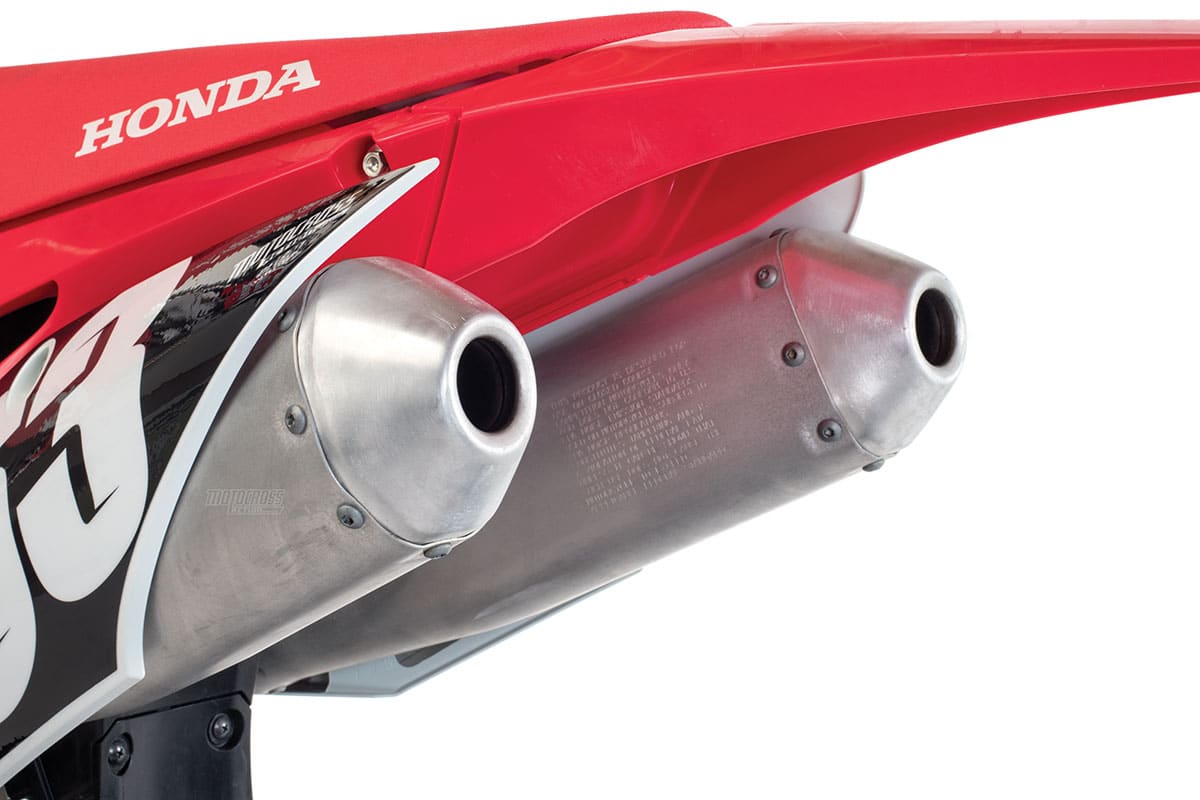
Q: HOW DOES THE CRF250 RUN ON THE TRACK?
A: Based solely on our dyno runs, we were thinking that it would outrun the all-new, high-rpm KX250 engine. We already knew that it suffered in comparison to the YZ250F, 250SXF and FC250 engines. In a surprise move, the 2020 Kawasaki KX250 adopted the exact same top-end style of power as the CRF250. It, too, revved to the moon but lacked the low-to-mid power that a racer needs to get cleanly out of a corner. No low translates into no-go—at least not on the exit of turns.
It is logical for us to compare the 2020 Kawasaki KX250 to the 2020 Honda CRF250 because they are fraternal twins. Note that we didn’t say identical twins because, on the track, the KX250 wakes up with authority, while the CRF250 runs like it is coming out of a deep sleep. The CRF250’s power takes time to build. On a 250 four-stroke, the power needs to be there at the first twist of the wrist, not later. We do want to point out that the 2020 CRF250’s low-end power is significantly improved from the 2018 CRF250 engine, but that isn’t saying much.
What the CRF250 does best is rev. It makes its peak power at 13,800 rpm, which is the same as the high-revving Husqvarna FC250. Both bikes make for a busy left hand and lazy left foot. This allows the shift points to be spread out to take advantage of the engine’s ability to rev. Honda understood this shifting phenomenon and made second gear on the 2020 CRF250 taller; however, it still needs a larger gap between second and third. We felt that lowering the stock gearing would help get the CRF250 out of corners better, but the short second gear makes doing this an issue. Testers would love to ride third everywhere, but the lack of low-end prowess makes it impossible.

Q: HOW DOES THE CRF250 HANDLE?
A: The 2020 CRF250 handles even better than it did with its updated chassis. It offers abundant comfort with its plush Showa components. The more rigid frame improves cornering ability and reduces flex under a load. The 2020 Honda CRF250 corners with the best of them; however, as with the razor-sharp Suzuki RM-Z250, it shakes at speed. Jumping on the CRF250, you feel right at home. It is predictable as they come.
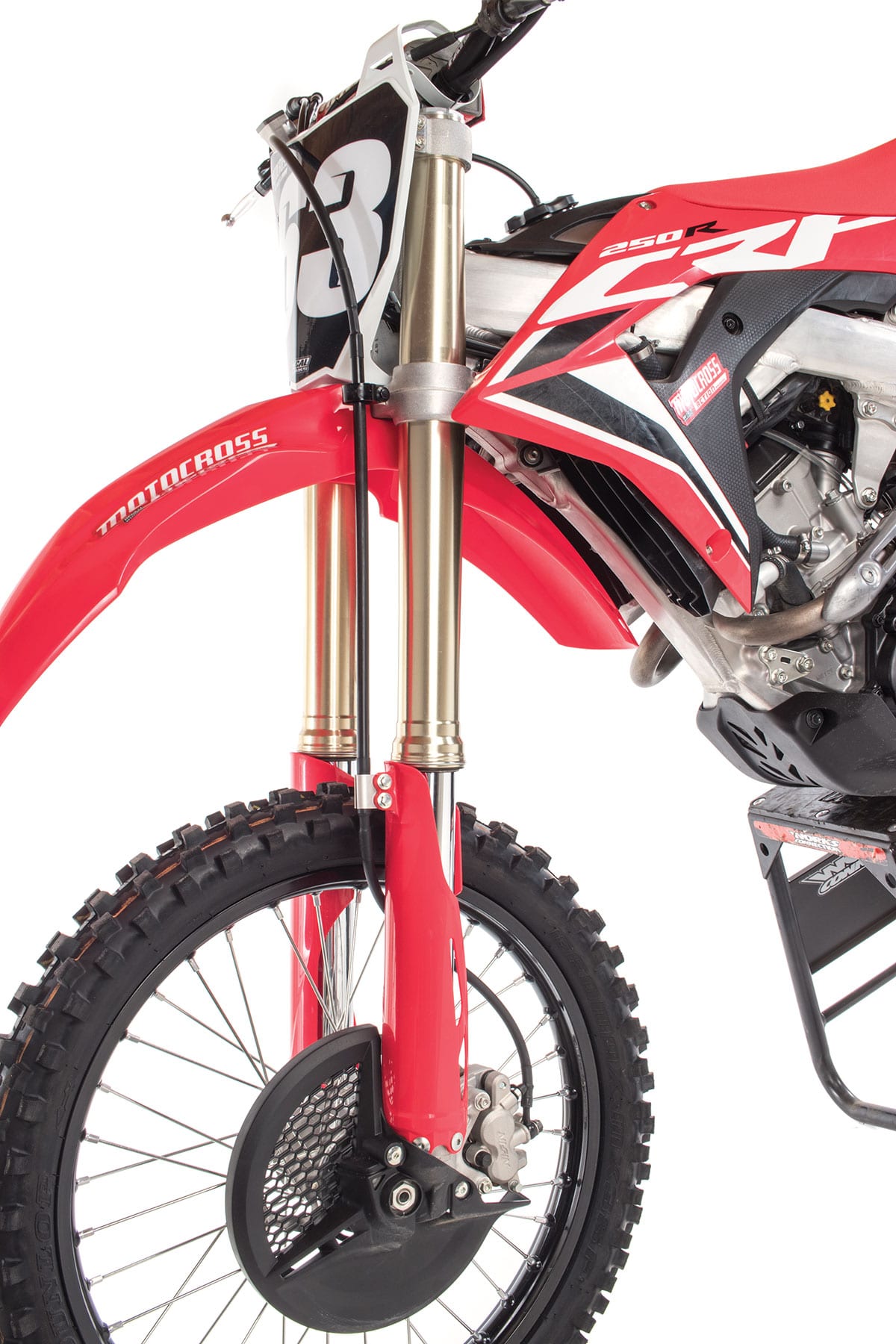
Q: ARE THE SHOWA COMPONENTS GREAT FOR EVERYONE?
A: The Showa forks and shock are great for most tracks and the majority of 250 riders; however, they are on the soft side and dive a lot. The best thing about the suspension is you always know what it will do. If the rear shock kicks out or wallows, it does it in slow motion so you can react to it. The downside of suspension like this is that it rides more like a Cadillac than a Corvette. On the plus side, it offers supreme comfort. On the negative side, it rides low in the stroke and doesn’t always stay planted when aiming for the inside line. Almost every test rider went stiffer on the forks and shock. If you are fast and ride at tracks that have technical rhythm sections or big jumps, the stock Showa setup will be too soft.

Q: DO THE THREE DIFFERENT ECU MAPS WORK WELL?
A: The three maps are more similar than we would like them to be. It was hard for many of our testers to feel a significant difference; however, the standard Map 1 was our favorite. It offered the most midrange power, and that helped the CRF250 get out of corners faster. Last year we asked Honda to put the CRF250X off-road bike maps in our CRF250 because it had vastly improved bottom and midrange power. Sadly, Honda told us that it was not possible to put the X-map in our CRF250 black box, but Jamie Ellis at Twisted Development can give you whatever style or power or map you want..
Q: IS THE EUROPEAN-SPEC CRF250 DIFFERENT FROM THE U.S.-SPEC CRF250?
A: Yes. Due to strict sound regulations in Europe, the Euro-bound CRF250s are muted by closing off the airbox vents, restricting the duel exhausts and changing the mapping.

Q: WHAT DID WE HATE?
A: The hate list:
(1) Powerband. For 2020 Honda made more power in all the right places—just not enough power from the bottom to middle.
(2) Weight. At 228 pounds, the CRF250 would not even be the lightest bike in the 450 class. It is 10 pounds heavier than the lightest 250 four-stroke (the 218-pound KTM 250SXF).
(3) Engine covers. The paint on the ignition and clutch cover gets scratched on the first ride.
(4) Maps. We want a more distinct difference between the three CRF250 maps.
(5) Dual exhaust. Unlike the CRF450’s one-into-two dual exhaust, the CRF250 actually has two different exhaust pipes and mufflers running down both sides of the bike. If this bike had the best powerband in the class, we could overlook the complexity, weight and replacement cost of twice pipes, but it doesn’t.
(6) Electric start. This may seem like a petty complaint, but Honda’s legal department aside, we want to be able to start the bike without having to pull in the clutch.
(7) Titanium gas tank. Making the gas tank out of titanium and then covering it with plastic is like wearing suspenders to hold your belt up. At least if we could see more than a smidgen of titanium it would have a cool factor.
Q: WHAT DID WE LIKE?
A: The like list:
(1) Handling. The bike turns well and is easy to ride for the masses.
(2) Forks. The Showa coil-spring forks work great for a wide range of riders.
(3) Clutch. Finally, Honda’s engineers put stiffer springs, better fiber plates and more oil into the previously pitiful clutch.
(4) Front brake. This is a good front brake—maybe not Brembo good, but it will get the job done.
(5) Footpegs. We like the sharper teeth on the footpegs; however, dirt still gets stuck inside the pivoting mechanism, making them stick up.
(6) Rear brake. The new rear brake pedal, pad material and shorter hose, along with drop-kicking the plastic rotor guard, are big steps forward for the CRF250 rear brake.
(7) Battery box. We aren’t big fans of bikes that tout their centralization of mass ideas while having 10 pounds more mass than their competition. Lowering the actual weight, on both the CRF450 and CRF250, would pay bigger dividends than lowering the weight’s position; however, moving the battery down 28mm helps get more air into the airbox.
Q: WHAT DO WE REALLY THINK?
A: We hate to watch a manufacturer struggle to recover from an engineering faux pas. Ever since introducing the new-generation, twin-pipe CRF250 in 2018, Honda has been in recovery mode. Given the harsh realities of corporate manufacturing, we know that Honda has made a valiant effort to make the bike better over the last three years; however, the real fix may lie in a total reworking of the engine’s design parameters, because three years of serious updates have not been able to overcome the built-in limitations (lack of low-to-mid throttle response). Paradoxically, we love the CRF250s superb ergos, spot-on chassis, top-end power and Showa suspension. The fly in the ointment of the 2020 CRF250 is that it needs to lose weight and find a lot more low-to-mid power if it wants to be more than a cellar dweller.
MXA’S 2020 HONDA CRF250 SETUP SPECS
This is how we set up our 2020 Honda CRF250 for racing. We offer it as a guide to help you find your own sweet spot.
SHOWA A-KIT SPRING FORKS
Honda hit the nail on the head with the valving and spring rates on the Showa coil-spring forks for the majority of riders. Initial settings were on the soft side for many riders. With the stock settings, the forks rode down in their stroke. We added a few clicks of compression to allow them to ride higher. Some of the riders also dropped the forks in the clamps 2mm to lessen oversteer. If you are experiencing oversteer, first drop the sag, then drop the forks. For hardcore racing, these are MXA’s recommended 2019 CRF250 fork settings (stock settings are in parentheses):
Spring rate: 4.8 N/mm
Compression: 7 clicks out (9 clicks out)
Rebound: 12 clicks out
Fork-leg height: 3mm
Notes: The forks worked well for the typical 250 four-stroke racer. Ride with these forks before you send them to your suspension guru. You might just be surprised how well these forks work for your weight and skill level. If you are on the lighter side, you might get head-shake. Try pushing the forks down in the clamps, making them flush with the cap to get rid of the shake.
SHOWA SHOCK SETTINGS
We ran the race sag at the recommend 100mm. Last year we ran it at 107mm. With the updated settings and chassis, the balance of the bike has changed. Overall, the stock settings are in the ballpark for most riders. For hardcore racing, these are MXA’s recommended 2020 CRF250 shock settings (stock settings are in parentheses):
Spring rate: 52 N/mm
Race sag: 100mm
Hi-compression: 3 turns out
Lo-compression: 9 clicks out (11 clicks out)
Rebound: 8 clicks out
Notes: The shock is consistent. It doesn’t do anything out of the ordinary. The bike does its best cornering at 100mm of sag. If you want more stability at speed, go down to 105mm, but you will give up the supreme cornering response.
2020 HONDA CRF250 MXA TEST VIDEO





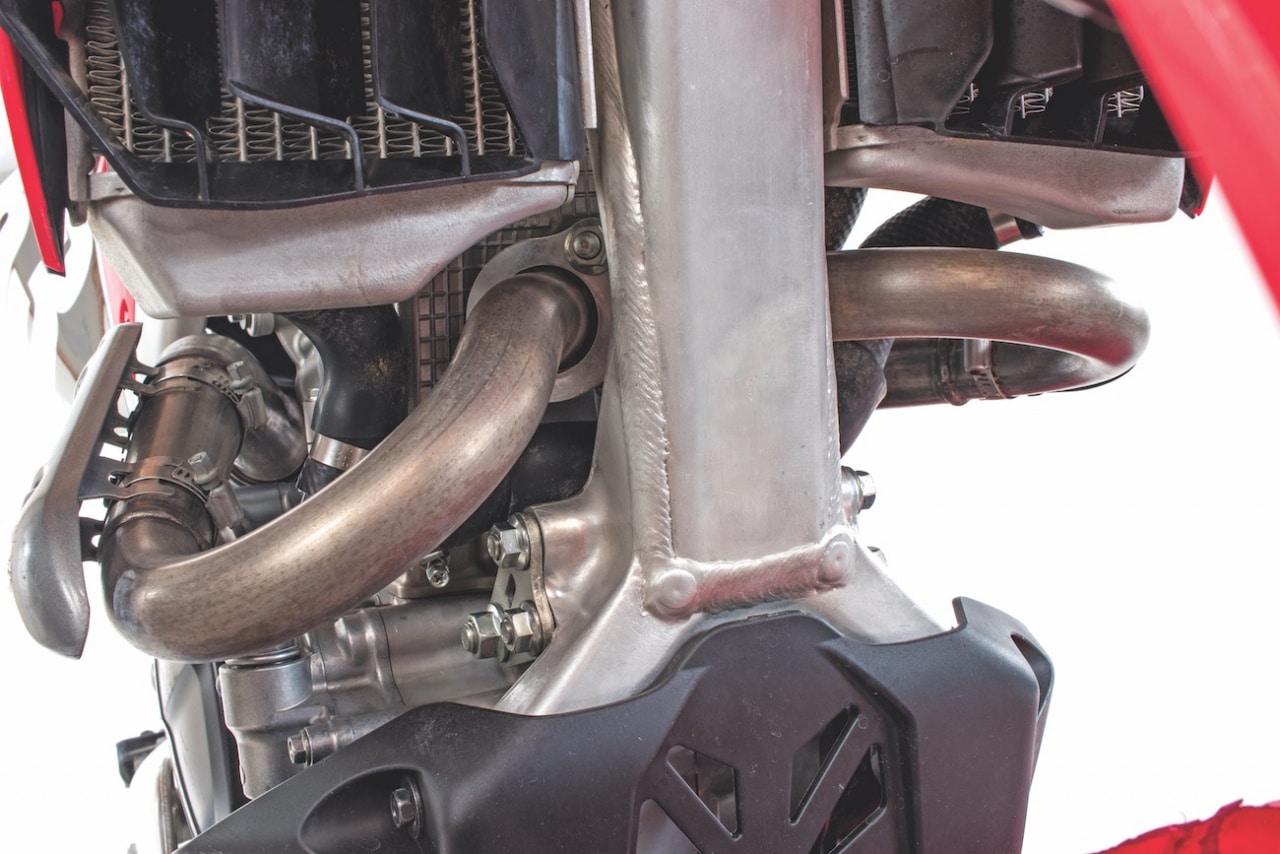
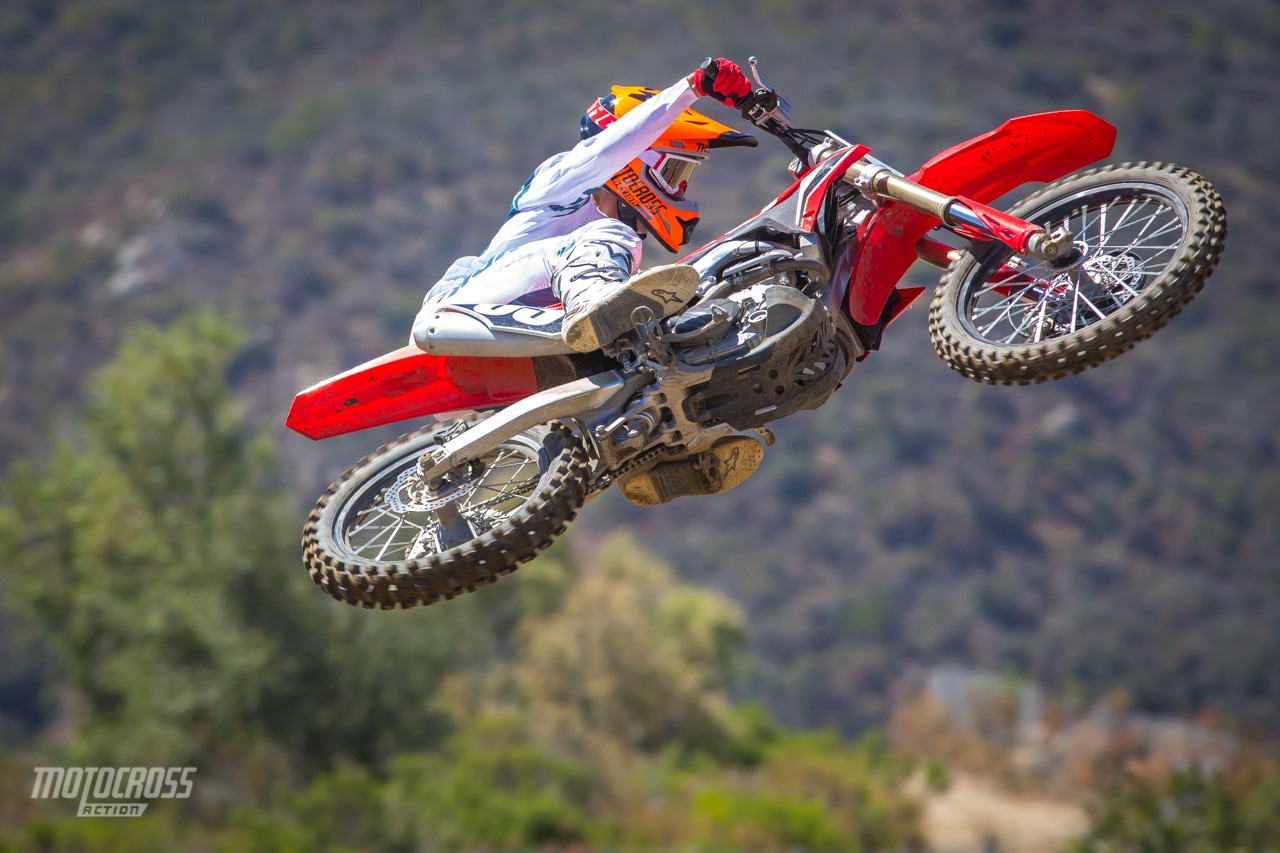


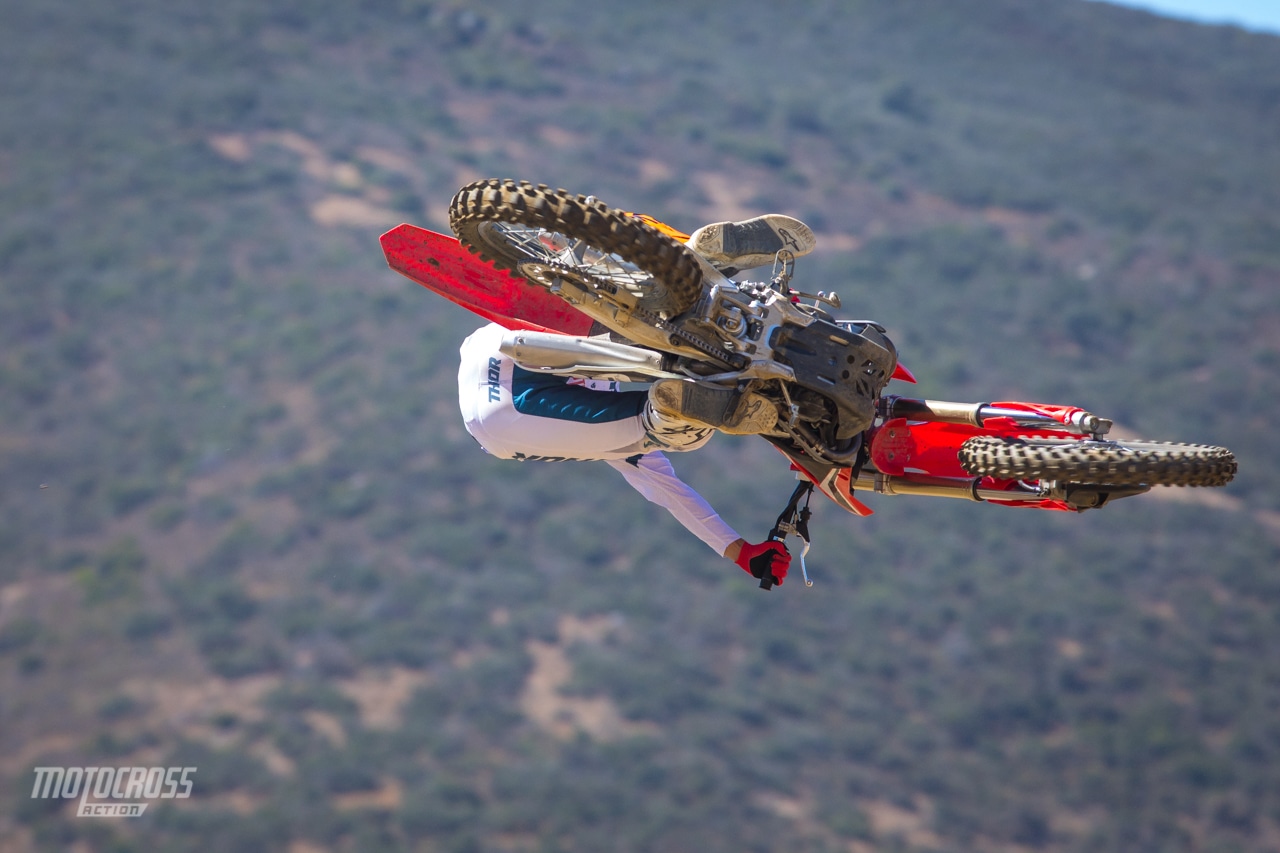


Comments are closed.